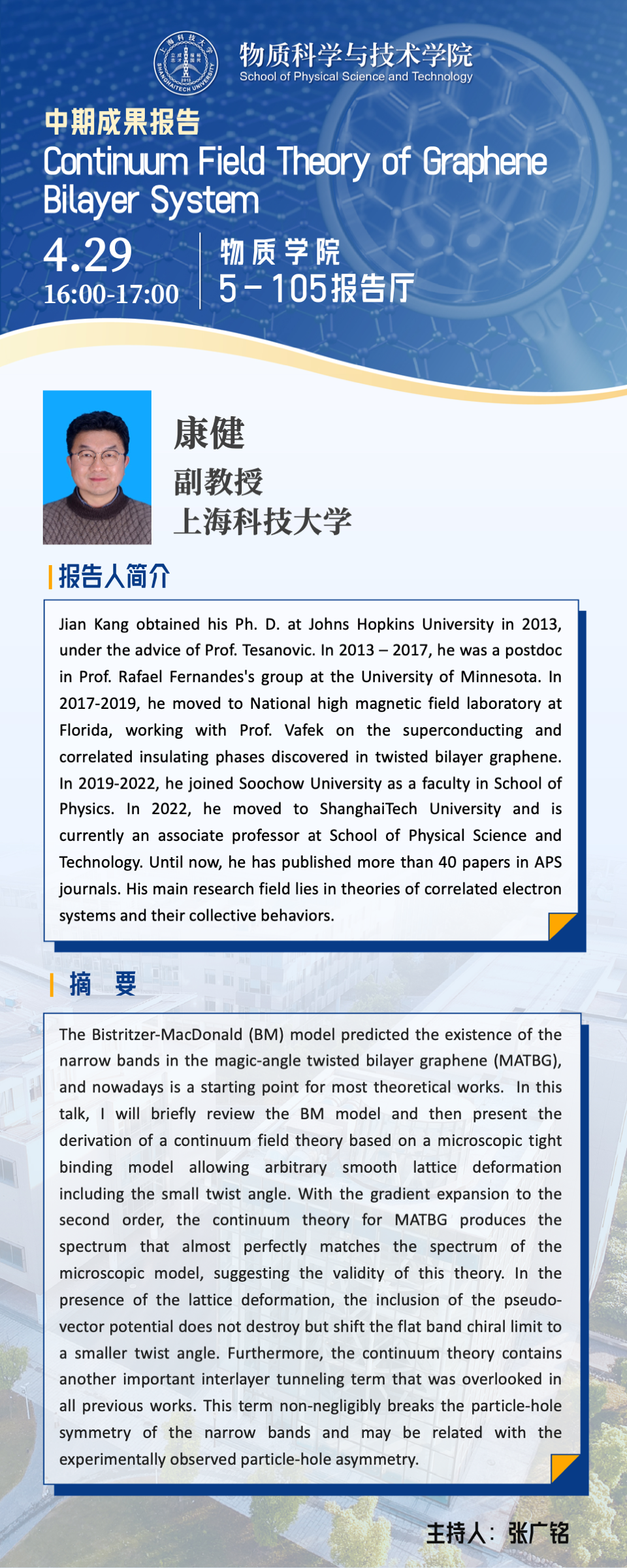X
+
-
重置

题目(Title):
Continuum Field Theory of Graphene Bilayer System
主讲人(Speaker):
康健
开始时间(Start Time):
2025-04-29 16:00
结束时间(End Time):
2025-04-29 17:00
报告地点(Place):
物质学院5-105报告厅
主办单位(Organization):
物质科学与技术学院
协办单位(Co-organizer):
简介(Brief Introduction):
报告人简介:
Jian Kang obtained his Ph. D. at Johns Hopkins University in 2013, under the advice of Prof. Tesanovic. In 2013 – 2017, he was a postdoc in Prof. Rafael Fernandes's group at the University of Minnesota. In 2017-2019, he moved to National high magnetic field laboratory at Florida, working with Prof. Vafek on the superconducting and correlated insulating phases discovered in twisted bilayer graphene. In 2019-2022, he joined Soochow University as a faculty in School of Physics. In 2022, he moved to ShanghaiTech University and is currently an associate professor at School of Physical Science and Technology. Until now, he has published more than 40 papers in APS journals. His main research field lies in theories of correlated electron systems and their collective behaviors.
讲座摘要:
The Bistritzer-MacDonald (BM) model predicted the existence of the narrow bands in the magic-angle twisted bilayer graphene (MATBG), and nowadays is a starting point for most theoretical works. In this talk, I will briefly review the BM model and then present the derivation of a continuum field theory based on a microscopic tight binding model allowing arbitrary smooth lattice deformation including the small twist angle. With the gradient expansion to the second order, the continuum theory for MATBG produces the spectrum that almost perfectly matches the spectrum of the microscopic model, suggesting the validity of this theory. In the presence of the lattice deformation, the inclusion of the pseudo-vector potential does not destroy but shift the flat band chiral limit to a smaller twist angle. Furthermore, the continuum theory contains another important interlayer tunneling term that was overlooked in all previous works. This term non-negligibly breaks the particle-hole symmetry of the narrow bands and may be related with the experimentally observed particle-hole asymmetry.
主持人:张广铭
Jian Kang obtained his Ph. D. at Johns Hopkins University in 2013, under the advice of Prof. Tesanovic. In 2013 – 2017, he was a postdoc in Prof. Rafael Fernandes's group at the University of Minnesota. In 2017-2019, he moved to National high magnetic field laboratory at Florida, working with Prof. Vafek on the superconducting and correlated insulating phases discovered in twisted bilayer graphene. In 2019-2022, he joined Soochow University as a faculty in School of Physics. In 2022, he moved to ShanghaiTech University and is currently an associate professor at School of Physical Science and Technology. Until now, he has published more than 40 papers in APS journals. His main research field lies in theories of correlated electron systems and their collective behaviors.
讲座摘要:
The Bistritzer-MacDonald (BM) model predicted the existence of the narrow bands in the magic-angle twisted bilayer graphene (MATBG), and nowadays is a starting point for most theoretical works. In this talk, I will briefly review the BM model and then present the derivation of a continuum field theory based on a microscopic tight binding model allowing arbitrary smooth lattice deformation including the small twist angle. With the gradient expansion to the second order, the continuum theory for MATBG produces the spectrum that almost perfectly matches the spectrum of the microscopic model, suggesting the validity of this theory. In the presence of the lattice deformation, the inclusion of the pseudo-vector potential does not destroy but shift the flat band chiral limit to a smaller twist angle. Furthermore, the continuum theory contains another important interlayer tunneling term that was overlooked in all previous works. This term non-negligibly breaks the particle-hole symmetry of the narrow bands and may be related with the experimentally observed particle-hole asymmetry.
主持人:张广铭



 沪公网安备 31011502006855号
沪公网安备 31011502006855号